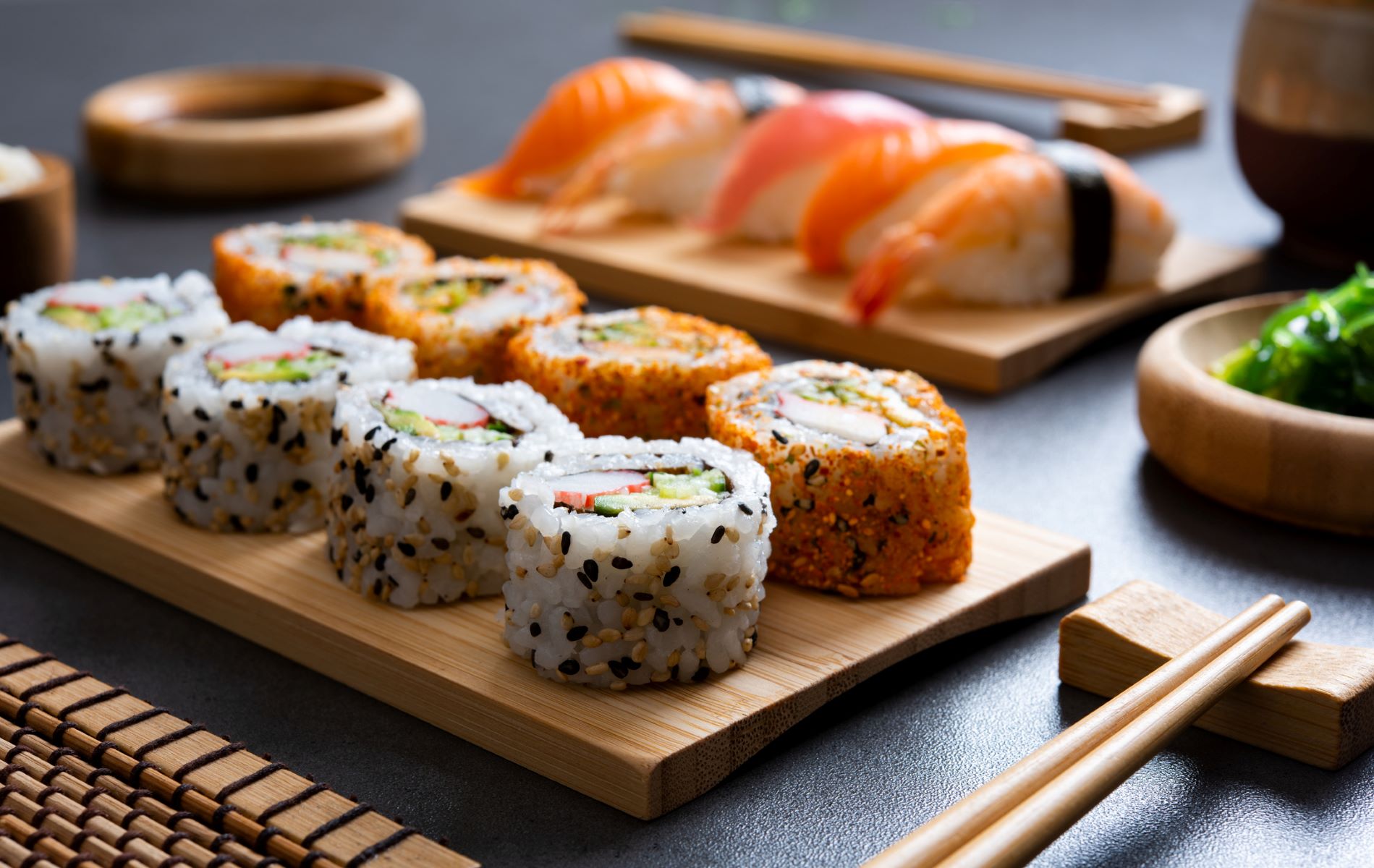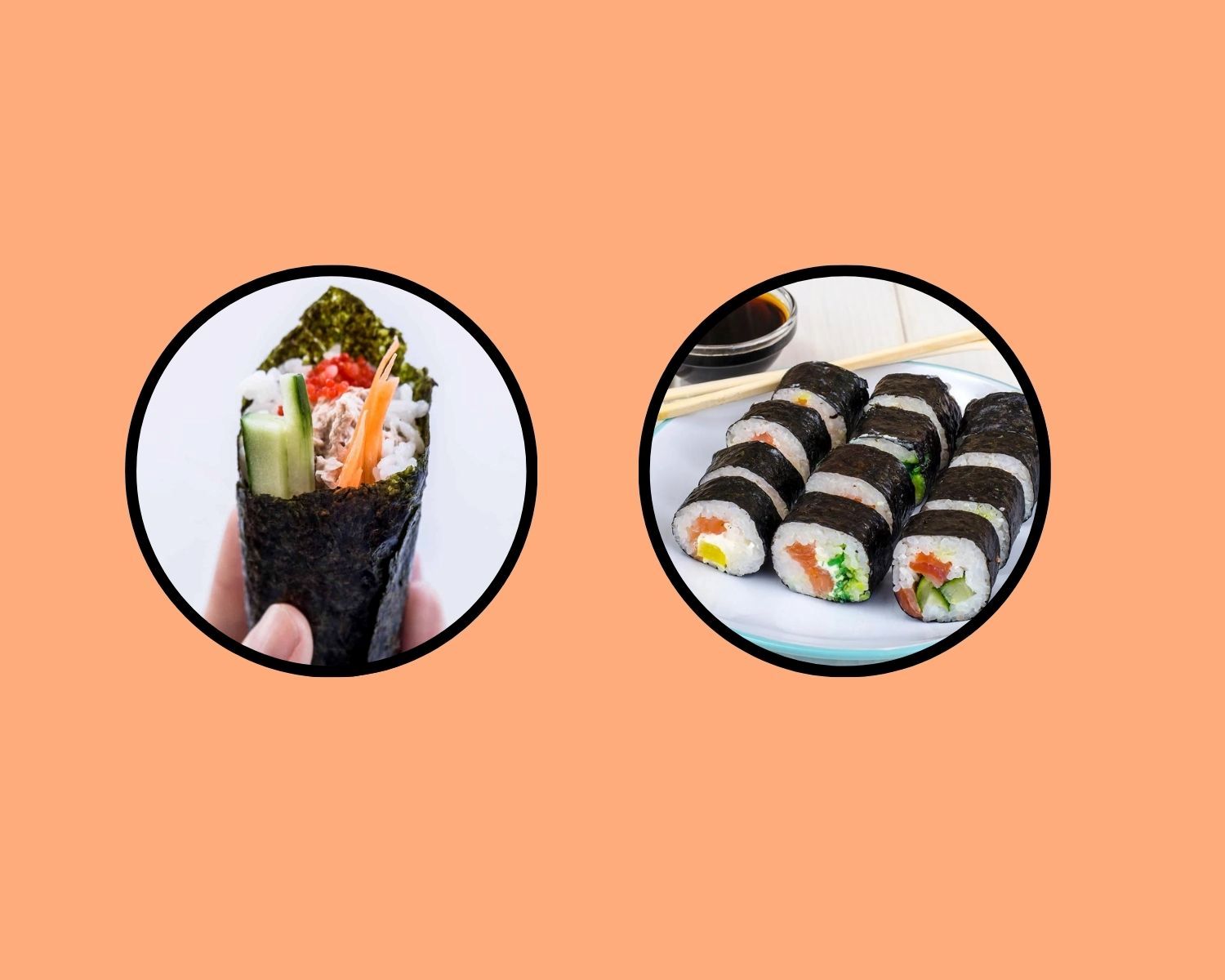Home>Food and Cooking>The Surprising Truth About The Deliciousness Of Cheap Sushi: Is Expensive Sushi Really Worth It?


Food and Cooking
The Surprising Truth About The Deliciousness Of Cheap Sushi: Is Expensive Sushi Really Worth It?
Published: February 1, 2024
Discover the truth about cheap and expensive sushi. Explore the deliciousness of both and find out if the extra cost is worth it. Learn more about food and cooking.
(Many of the links in this article redirect to a specific reviewed product. Your purchase of these products through affiliate links helps to generate commission for Regretless.com, at no extra cost. Learn more)
Table of Contents
Introduction
Sushi, the iconic Japanese dish, has captivated the palates of food enthusiasts around the world. Its delicate balance of flavors, textures, and presentation has elevated it to a culinary art form. However, the perception of sushi has evolved significantly over the years, particularly with the emergence of affordable, grab-and-go options that have made this delectable dish more accessible than ever. This shift has sparked a debate: does the price tag truly reflect the quality and taste of sushi?
In this article, we delve into the fascinating world of sushi, exploring its rich history, the rise of affordable sushi options, and the intriguing question of whether expensive sushi is truly worth the investment. By examining the quality, taste, and health considerations associated with both cheap and expensive sushi, we aim to unravel the truth behind the perceived disparity in value.
As we embark on this culinary journey, we invite you to set aside preconceived notions and join us in exploring the surprising truth about the deliciousness of cheap sushi and the real worth of its expensive counterpart. Let's uncover the intricacies of sushi, from its traditional roots to its modern interpretations, and discover the factors that truly determine the value of this beloved Japanese delicacy.
The History and Art of Sushi
Sushi, a culinary masterpiece that has transcended cultural boundaries, boasts a rich history that dates back centuries. Its origins can be traced to Southeast Asia, where the practice of preserving fish in fermented rice served as a means of food preservation. Over time, this preservation method evolved, eventually reaching Japan in the 8th century.
Initially, sushi was not intended for direct consumption. Instead, it was utilized as a preservation technique to ferment fish with rice, a process that would take several months. As the fermentation progressed, the rice was discarded, and only the preserved fish was consumed. This early form of sushi, known as narezushi, laid the foundation for the culinary artistry that would later captivate the world.
In the Edo period (1603-1868), a significant transformation occurred, marking the birth of what we now recognize as sushi. Street food stalls, known as yatai, began offering a type of fast food called nigiri sushi, which consisted of hand-pressed rice topped with fresh fish. This innovation revolutionized the way sushi was prepared and consumed, setting the stage for its widespread popularity.
The meticulous craftsmanship and attention to detail involved in sushi preparation have elevated it to an art form. Sushi chefs, or itamae, undergo rigorous training to master the delicate art of sushi-making, honing their skills in rice preparation, fish selection, and knife techniques. The presentation of sushi is equally significant, with emphasis placed on aesthetic appeal and balance of colors and textures.
Today, sushi has evolved into a diverse culinary experience, with traditional styles such as nigiri and maki coexisting alongside modern interpretations like sashimi and tempura rolls. The cultural significance of sushi extends beyond its culinary allure, embodying a harmonious blend of tradition, innovation, and meticulous artistry.
As we delve into the history and art of sushi, it becomes evident that this revered dish is not merely a culinary creation but a reflection of Japanese culture, craftsmanship, and the pursuit of gastronomic perfection. The evolution of sushi from a humble preservation method to a globally celebrated delicacy is a testament to its enduring legacy and the artistry that continues to enchant sushi enthusiasts worldwide.
The Rise of Cheap Sushi
In recent years, the culinary landscape has witnessed a notable shift in the accessibility and affordability of sushi. The rise of cheap sushi, often synonymous with quick-service outlets and grab-and-go options, has redefined the traditional perception of this esteemed Japanese dish. This evolution has been propelled by several factors that have reshaped the sushi industry and transformed the dining experience for consumers.
One of the primary catalysts behind the proliferation of affordable sushi is the demand for convenience and on-the-go dining. As modern lifestyles become increasingly fast-paced, consumers seek quick and convenient meal options that align with their dynamic routines. This shift in consumer behavior has prompted the emergence of sushi chains, supermarkets, and fast-casual eateries that offer budget-friendly sushi selections, catering to the demand for accessible and portable meals.
Furthermore, advancements in food production and distribution have played a pivotal role in making sushi more affordable and widely available. Improved techniques for fish sourcing, processing, and preservation have enabled suppliers to offer cost-effective sushi ingredients without compromising quality. Additionally, the utilization of automation and standardized production processes has streamlined the preparation of sushi, reducing labor costs and ultimately contributing to the affordability of the final product.
The cultural assimilation of sushi into mainstream culinary preferences has also contributed to the rise of cheap sushi. As sushi continues to transcend its traditional roots and appeal to a global audience, the demand for budget-friendly sushi options has surged. This has prompted restaurants and food establishments to diversify their offerings, introducing value-oriented sushi menus that cater to a broader demographic and appeal to cost-conscious consumers.
Moreover, the innovative fusion of traditional sushi elements with modern culinary trends has given rise to creative and affordable sushi variations. From sushi burritos to customizable sushi bowls, these inventive adaptations have redefined the notion of affordable sushi, presenting consumers with an array of budget-friendly options that align with evolving taste preferences and dietary choices.
The rise of cheap sushi represents a significant evolution in the culinary landscape, marking a departure from the traditional exclusivity of sushi dining and embracing a more inclusive and accessible approach. As affordable sushi continues to gain prominence, it challenges conventional perceptions of sushi dining, inviting a diverse audience to savor the flavors and artistry of this beloved Japanese delicacy.
The Quality of Cheap Sushi
The affordability of cheap sushi prompts a critical examination of its quality, dispelling misconceptions and shedding light on the factors that define its value. While the term "cheap" may evoke notions of inferiority, the quality of budget-friendly sushi is not solely determined by its price point. Instead, it encompasses a nuanced interplay of ingredients, preparation methods, and culinary expertise.
In evaluating the quality of cheap sushi, it is essential to consider the sourcing and freshness of ingredients. Despite its accessible price, reputable establishments prioritize the use of high-quality, fresh fish and seafood, ensuring that the fundamental elements of sushi adhere to stringent standards. Additionally, the rice, a cornerstone of sushi, undergoes meticulous preparation, with attention to texture, flavor, and seasoning, regardless of the sushi's affordability.
The skill and expertise of sushi chefs play a pivotal role in shaping the quality of cheap sushi. While budget-friendly sushi may be associated with quick-service settings, the proficiency of sushi chefs in crafting and presenting each piece reflects a commitment to upholding the essence of sushi artistry. Their precision in slicing fish, shaping rice, and mastering flavor combinations contributes to the overall quality of affordable sushi offerings.
Furthermore, the adherence to food safety and hygiene practices is non-negotiable, irrespective of the price bracket. Establishments offering cheap sushi prioritize stringent food handling protocols, ensuring that the sushi production process complies with industry standards. This commitment to food safety reinforces the quality and integrity of affordable sushi, assuring consumers of a safe and enjoyable dining experience.
It is important to recognize that the quality of cheap sushi extends beyond the individual components to encompass the overall dining experience. From the ambiance of the establishment to the attentiveness of the service, the holistic presentation of budget-friendly sushi contributes to its perceived quality. The accessibility and inclusivity of affordable sushi offerings further enhance the overall dining experience, inviting a diverse audience to partake in the culinary artistry of sushi.
In essence, the quality of cheap sushi transcends its economical pricing, embodying a harmonious fusion of premium ingredients, culinary mastery, and a commitment to excellence. By dispelling preconceived notions and embracing the complexities of affordable sushi, consumers can appreciate the value and quality that characterize this modern interpretation of a timeless culinary tradition.
The Cost of Expensive Sushi
Expensive sushi, often synonymous with upscale dining establishments and renowned sushi bars, embodies a culinary experience that transcends mere sustenance, elevating dining to an artful and indulgent affair. The cost of partaking in this gastronomic luxury reflects a confluence of factors that contribute to the perceived value and exclusivity of premium sushi offerings.
At the forefront of the cost consideration for expensive sushi is the meticulous sourcing of premium ingredients. Renowned for its emphasis on pristine seafood, exquisite cuts of fish, and rare delicacies, expensive sushi establishments spare no expense in procuring the finest and freshest ingredients. From prized varieties of tuna to meticulously cultivated seaweed and artisanal soy sauces, the commitment to sourcing premium components underscores the elevated experience that defines expensive sushi.
The expertise and artistry of sushi chefs further contribute to the cost of expensive sushi. Renowned itamae, revered for their mastery of sushi craftsmanship, undergo extensive training and apprenticeships to perfect their skills, culminating in the ability to curate extraordinary dining experiences. The precision in filleting fish, the artful composition of nigiri, and the delicate balance of flavors exemplify the dedication and artistry that justify the premium cost associated with expensive sushi.
The ambiance and dining experience offered by upscale sushi establishments also factor into the cost of expensive sushi. Impeccably designed interiors, attentive service, and a curated selection of sake and wine complement the culinary journey, creating an immersive and luxurious dining environment. The attention to detail in presentation, from custom-designed servingware to the theatrical preparation of sushi, further enhances the allure of the expensive sushi experience, contributing to its elevated cost.
Additionally, the exclusivity and rarity of certain ingredients, such as seasonal delicacies and limited-availability seafood, contribute to the premium pricing of expensive sushi. The pursuit of exceptional and ethically sourced ingredients, coupled with the dedication to preserving traditional techniques, further amplifies the cost of indulging in this revered culinary art form.
Ultimately, the cost of expensive sushi transcends monetary value, embodying a symphony of culinary mastery, premium ingredients, and an immersive dining experience. The investment in expensive sushi extends beyond the price tag, encapsulating a celebration of tradition, innovation, and the pursuit of gastronomic excellence.
The Quality of Expensive Sushi
The quality of expensive sushi transcends mere culinary excellence, embodying an exquisite fusion of premium ingredients, unparalleled artistry, and an unwavering commitment to gastronomic perfection. At the heart of this culinary opulence lies a symphony of elements that converge to define the unparalleled quality that distinguishes expensive sushi from its counterparts.
Central to the exceptional quality of expensive sushi is the uncompromising standard of ingredients. Renowned for its emphasis on pristine seafood, rare delicacies, and artisanal components, expensive sushi establishments meticulously curate a selection of ingredients that epitomize the pinnacle of culinary indulgence. From the opulent marbling of prized Otoro tuna to the delicate translucency of Hokkaido scallops, each component is meticulously sourced to ensure unparalleled freshness, flavor, and sustainability.
The expertise and artistry of sushi chefs elevate the quality of expensive sushi to unprecedented heights. Renowned itamae, revered for their mastery of sushi craftsmanship, undergo rigorous training and apprenticeships to hone their skills, culminating in the ability to orchestrate extraordinary dining experiences. The precision in filleting fish, the artful composition of nigiri, and the delicate balance of flavors exemplify the dedication and artistry that justify the premium cost associated with expensive sushi.
Furthermore, the dining experience at upscale sushi establishments reflects a commitment to unparalleled quality. Impeccably designed interiors, personalized service, and a curated selection of sake and wine contribute to an immersive and luxurious dining environment. The attention to detail in presentation, from custom-designed servingware to the theatrical preparation of sushi, further enhances the allure of the expensive sushi experience, elevating it to an unparalleled standard of quality.
The exclusivity and rarity of certain ingredients further underscore the exceptional quality of expensive sushi. Seasonal delicacies, limited-availability seafood, and meticulously cultivated accompaniments contribute to the exclusivity and allure of the dining experience, encapsulating a celebration of tradition, innovation, and the pursuit of gastronomic excellence.
In essence, the quality of expensive sushi transcends the realm of culinary artistry, embodying a harmonious convergence of premium ingredients, masterful craftsmanship, and an immersive dining experience. The investment in expensive sushi represents a celebration of tradition, innovation, and the relentless pursuit of perfection, culminating in an unparalleled sensory journey that transcends the ordinary and redefines the essence of gastronomic indulgence.
The Taste Test: Cheap vs. Expensive Sushi
Embarking on a taste test journey to discern the nuances of cheap versus expensive sushi unveils a captivating exploration of flavors, textures, and culinary craftsmanship. The stark dichotomy between these two culinary experiences invites a sensory odyssey that transcends mere sustenance, offering a profound insight into the essence of sushi dining.
Cheap sushi, often associated with grab-and-go convenience and budget-friendly offerings, presents a medley of flavors that reflect accessibility and contemporary culinary trends. The affordability of cheap sushi does not diminish its potential for delightful flavors and satisfying textures. From the familiar succulence of salmon to the briny sweetness of shrimp, affordable sushi offerings cater to a diverse palate, presenting an array of options that resonate with modern dining preferences.
In contrast, the taste test of expensive sushi unveils an extraordinary symphony of flavors that epitomize culinary indulgence. Each meticulously crafted piece of nigiri embodies a sensorial journey, from the rich umami of premium tuna to the delicate sweetness of hand-selected sea urchin. The interplay of flavors in expensive sushi reflects a profound reverence for the art of sushi-making, elevating the dining experience to an unparalleled realm of gastronomic opulence.
The texture of sushi, a defining element of its sensory allure, distinguishes cheap and expensive offerings with remarkable subtlety. Budget-friendly sushi delights with its approachable textures, offering a harmonious blend of tender fish, seasoned rice, and crisp nori. The accessibility of cheap sushi is further accentuated by its approachable textures, inviting diners to savor the familiar comfort of each bite.
Conversely, the texture of expensive sushi transcends the ordinary, captivating the palate with an exquisite interplay of supple, buttery fish and velvety rice that dissolves effortlessly. The meticulous attention to textural harmony in expensive sushi reflects the dedication to culinary mastery, presenting a sensory experience that transcends the ordinary and redefines the essence of gastronomic indulgence.
In essence, the taste test of cheap versus expensive sushi unveils a captivating narrative of flavors and textures, each offering a distinct expression of culinary artistry. Whether savoring the accessible delights of budget-friendly sushi or indulging in the opulence of premium offerings, the taste test serves as a testament to the diverse and enchanting world of sushi dining, inviting enthusiasts to embark on a sensory odyssey that celebrates the multifaceted allure of this beloved Japanese delicacy.
The Health Considerations
When contemplating the consumption of sushi, whether it be affordable or upscale, it is imperative to consider the health implications associated with this beloved culinary delight. Sushi, renowned for its emphasis on fresh seafood, rice, and seaweed, offers a spectrum of nutritional benefits that align with a balanced and health-conscious diet.
Affordable sushi, despite its accessible pricing, maintains a focus on key elements that contribute to its nutritional value. The incorporation of omega-3 rich fish such as salmon and mackerel provides essential fatty acids that support heart health and cognitive function. Additionally, the inclusion of nutrient-dense seaweed, a prominent component in sushi rolls, introduces a host of vitamins, minerals, and antioxidants that bolster immune function and promote overall well-being. The use of seasoned rice, a staple in sushi preparation, offers a source of carbohydrates for sustained energy, complementing the nutritional profile of affordable sushi offerings.
Expensive sushi, characterized by its emphasis on premium seafood and artisanal ingredients, further underscores the health considerations associated with sushi consumption. The utilization of high-quality fish varieties, renowned for their lean protein content and omega-3 fatty acids, aligns with dietary recommendations for supporting cardiovascular health and muscle function. Furthermore, the meticulous selection of ingredients in upscale sushi, such as rare seaweed varieties and specialty rice blends, contributes to a diverse and nutrient-rich dining experience that transcends mere indulgence.
In both affordable and expensive sushi, the minimal processing of ingredients and the absence of heavy sauces or excessive additives align with contemporary dietary preferences that emphasize whole, unprocessed foods. This culinary approach resonates with individuals seeking wholesome and nourishing dining options, reflecting a commitment to culinary integrity and nutritional value.
It is worth noting that while sushi offers a plethora of health benefits, considerations should be given to potential allergens, mercury content in certain fish varieties, and the overall balance of the sushi meal. Moderation and mindful consumption remain essential practices when enjoying sushi, ensuring that the nutritional benefits are maximized while addressing individual dietary needs and preferences.
In essence, the health considerations associated with both affordable and expensive sushi underscore the amalgamation of wholesome ingredients, essential nutrients, and culinary integrity. Whether savoring the accessibility of budget-friendly sushi or indulging in the nutritional opulence of premium offerings, the health-conscious consumer can find solace in the diverse and nourishing attributes of this revered Japanese delicacy.
Conclusion
In the realm of sushi dining, the dichotomy between affordable and expensive offerings transcends mere pricing, offering a multifaceted exploration of culinary artistry, sensory delight, and nutritional value. The evolution of sushi, from its humble origins to its modern interpretations, reflects a dynamic fusion of tradition and innovation, inviting enthusiasts to embark on a captivating journey that celebrates the essence of Japanese gastronomy.
The rise of affordable sushi has redefined the accessibility and inclusivity of this revered culinary tradition, challenging conventional perceptions and inviting a diverse audience to partake in its flavors and artistry. The quality of budget-friendly sushi, characterized by meticulous ingredient sourcing, culinary expertise, and a commitment to excellence, dispels misconceptions and presents a compelling case for its value and appeal. The taste test of cheap versus expensive sushi unveils a captivating narrative of flavors and textures, each offering a distinct expression of culinary artistry.
Conversely, expensive sushi embodies an unparalleled standard of gastronomic opulence, characterized by premium ingredients, masterful craftsmanship, and an immersive dining experience. The investment in expensive sushi represents a celebration of tradition, innovation, and the relentless pursuit of perfection, culminating in an unparalleled sensory journey that transcends the ordinary and redefines the essence of gastronomic indulgence.
Both affordable and expensive sushi offerings present a spectrum of nutritional benefits, aligning with contemporary dietary preferences and offering a diverse and nourishing dining experience. The amalgamation of wholesome ingredients, essential nutrients, and culinary integrity underscores the health-conscious attributes of sushi, providing consumers with a culinary indulgence that resonates with their well-being and dietary considerations.
As we conclude this exploration of the surprising truth about the deliciousness of cheap sushi and the real worth of its expensive counterpart, it becomes evident that the value of sushi transcends monetary considerations, embodying a celebration of tradition, innovation, and the pursuit of culinary excellence. Whether savoring the accessibility of budget-friendly sushi or indulging in the opulence of premium offerings, enthusiasts are invited to partake in a sensory odyssey that celebrates the multifaceted allure of this beloved Japanese delicacy.














